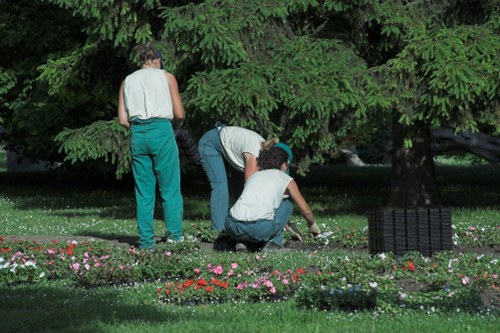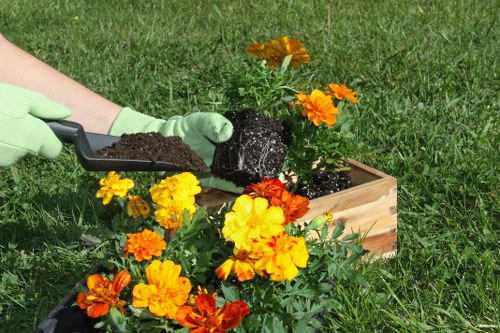Tree Lopping and Removal in Temple
Importance of Tree Maintenance in Temples

Temples are not just places of worship but also sanctuaries that harmonize nature and spirituality. The presence of trees within temple grounds enhances the serene environment, providing shade, oxygen, and a connection to the natural world. Proper tree lopping and removal are essential practices to maintain the aesthetic and structural integrity of these sacred spaces.
Regular maintenance ensures that trees do not become a hazard to the temple structures or the visitors. Overgrown branches can pose risks during adverse weather conditions, and dead or diseased trees can attract pests. Therefore, a proactive approach to tree pruning and removal is crucial for the safety and beauty of temple environments.
Additionally, well-maintained trees contribute to the ecological balance of the area, supporting local wildlife and promoting biodiversity. The interplay between trees and temple architecture creates a harmonious setting that inspires devotion and tranquility among devotees.
Reasons for Tree Lopping and Removal

There are several reasons why tree lopping and removal become necessary in temple settings:
- Safety Concerns: Dead or unstable branches can fall and cause injuries or damage.
- Structural Integrity: Tree roots can affect the foundations of temple buildings.
- Health of Trees: Diseased or infested trees can spread problems to other healthy trees.
- Aesthetic Maintenance: Overgrown trees can overshadow temple structures, detracting from their appearance.
- Environmental Protection: Removing invasive species helps preserve native biodiversity.
Addressing these issues through tree maintenance ensures that the temple remains a safe and inviting place for worshippers.
Furthermore, seasonal changes and natural growth patterns necessitate regular attention to tree care, ensuring that the temple landscape remains orderly and beautiful throughout the year.
Best Practices for Tree Lopping in Temple Grounds

Implementing best practices for tree lopping and removal in temple grounds involves several key steps:
- Assessment: Conduct a thorough inspection of the trees to determine their health and stability.
- Planning: Develop a strategy that minimizes disruption to the temple activities and preserves the overall landscape.
- Execution: Utilize professional tree care services to perform the lopping or removal safely and efficiently.
- Post-Removal Care: Address any damages caused by tree removal and implement measures to prevent future issues.
- Regular Maintenance: Schedule routine inspections and maintenance to keep the trees and temple grounds in optimal condition.
Adhering to these practices ensures that tree management supports the temple's spiritual mission while maintaining environmental and structural harmony.
Moreover, involving the temple community in tree care initiatives can foster a sense of responsibility and connection to the natural elements surrounding the sacred space.
Choosing the Right Tree Removal Services

Selecting a reputable and experienced tree removal service is vital for effective maintenance of temple grounds. Here are some factors to consider:
- Experience: Ensure the service provider has a proven track record in tree lopping and removal.
- Certifications: Look for certifications and insurance that guarantee professional standards and safety.
- References: Check reviews or ask for references to gauge customer satisfaction.
- Equipment: Confirm that the team uses the latest and safest equipment for tree removal.
- Environmental Practices: Choose services that follow eco-friendly practices, such as recycling tree waste.
Engaging the right professionals not only ensures the job is done correctly but also respects the temple's environmental and spiritual values.
Additionally, clear communication with the service provider about the temple's specific needs and restrictions can lead to a more tailored and respectful approach to tree management.
Environmental Impact of Tree Removal

While tree removal is sometimes necessary, it is important to consider its environmental impact. Trees play a significant role in:
- Carbon Sequestration: Absorbing carbon dioxide and reducing greenhouse gases.
- Biodiversity: Providing habitats for various species of flora and fauna.
- Water Regulation: Influencing the water cycle and maintaining soil integrity.
- Air Quality: Filtering pollutants and improving overall air quality.
Therefore, tree removal should be approached with caution, ensuring that it is justified and that efforts are made to mitigate any negative effects.
Implementing sustainable practices, such as replanting native species and protecting remaining forests, can help preserve the ecological balance while meeting the temple's maintenance needs.
Legal and Ethical Considerations

Tree lopping and removal in temple areas must comply with local laws and ethical guidelines. This includes:
- Permits: Obtaining necessary permits before removing trees, especially protected or heritage species.
- Regulations: Adhering to environmental regulations that govern tree management.
- Community Impact: Considering the effects on the local community and ecosystem.
- Ethical Practices: Ensuring that tree removal is conducted responsibly and respectfully.
Failure to comply with these considerations can result in legal repercussions and harm to the temple's reputation.
Engaging with environmental experts and legal advisors can help navigate the complexities of tree management, ensuring that actions taken are both lawful and morally sound.
Conclusion and Call to Action

Effective tree lopping and removal are essential for the safety, beauty, and ecological balance of temple grounds. By following best practices, choosing the right services, and considering environmental and legal factors, temples can maintain their sacred spaces harmoniously.
We encourage temple administrators and community members to prioritize tree maintenance as a fundamental aspect of temple care. Investing in professional tree services not only preserves the temple's integrity but also supports a healthy and vibrant environment for all who visit.
Contact us today to learn more about our specialized tree lopping and removal services tailored for temple environments. Let us help you maintain a safe, beautiful, and spiritually uplifting space for your community.